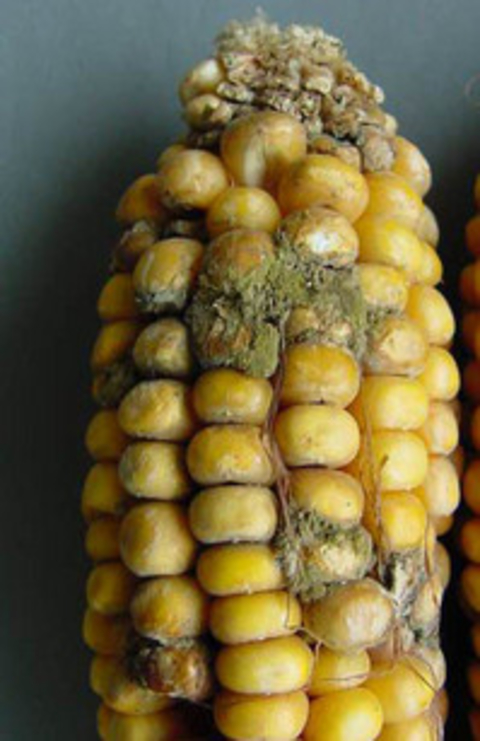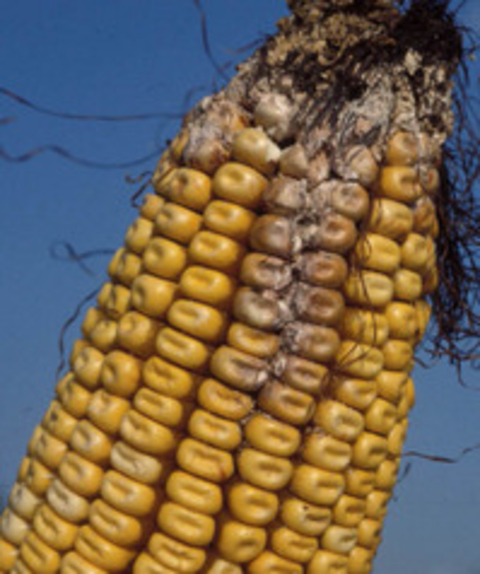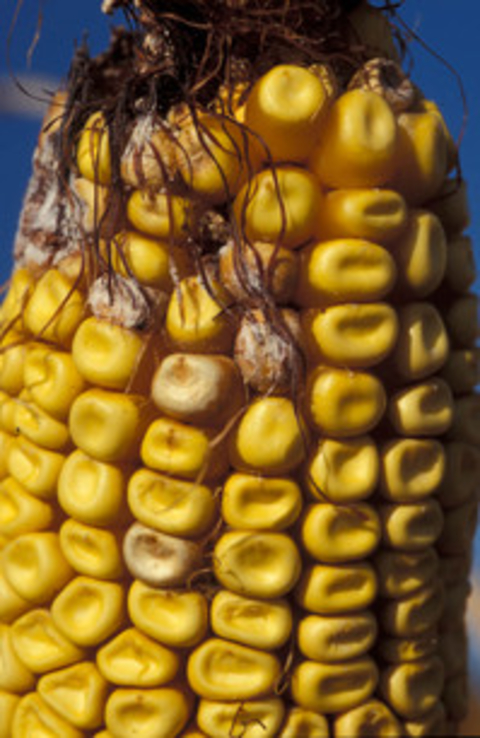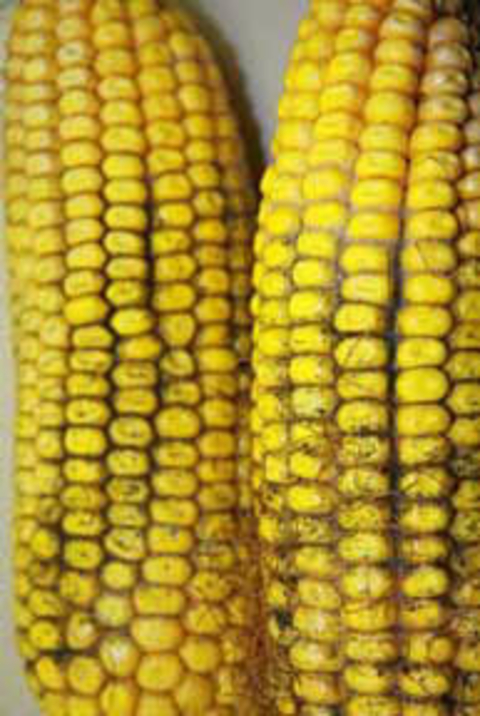Aspergillus ear rot and Fusarium ear rot are of greatest concern in Minnesota because they can produce mycotoxins. These toxins can cause serious health problems in both humans and animals if they eat contaminated food or feed.
Grain must be tested to determine if mycotoxins are present.
Aspergillus ear rot and Fusarium ear rot are favored by hot, dry conditions.
Other ear rots occur in Minnesota, but they are often favored by wet conditions and have not produced mycotoxins.
Several different types of ear rots occur in Minnesota. Ear rots are important because they can decrease yield and significantly reduce grain quality.
Aspergillus ear rot and Fusarium ear rot are of greatest concern because they produce mycotoxins. These ear rots are favored by hot and dry conditions.
Aspergillus ear rot
Aspergillus ear rot can produce aflatoxin, a potent mycotoxin that is toxic to animals and humans.
Aspergillus ear rot can become a problem when soil conditions are dry and temperatures are greater than 89 degrees F.
This ear rot is caused by the fungus Aspergillus flavus. Look for patches of green to yellow spores on or between the kernels (Figure 1). These symptoms can become dark olive green to brown as the ear rot ages.
Aspergillus ear rot is most common at the ear tips and often only affects a few kernels or small areas of the ear (Figure 2).
Aspergillus species can also cause storage rot. This fungus can invade kernels when moisture levels are as low as 15 percent, especially if kernels have been damaged.
The presence of the Aspergillus ear rot does not mean the corn has high levels of aflatoxin. The grain must be tested to determine how much aflatoxin is present. Different types of screening tests for aflatoxin are available:
- A simple black light test that indicates the potential for aflatoxin.
- Commercial test kits
- Chemical methods that measure aflatoxin levels.
The University of Minnesota Veterinary Diagnostic Laboratory can test grain samples for aflatoxin and other mycotoxins. Other universities and private laboratories in the region can also test grain samples.
Table 1. Action levels for total aflatoxins in livestock feed.
| Class of animals | Feed type | Aflatoxin level |
|---|---|---|
| Finishing beef cattle | Corn and other grains | 300 ppb |
| Beef cattle, swine or poultry | Cottonseed meal | 300 ppb |
| Finishing swine of 100 lb. or greater | Corn and other grains | 200 ppb |
| Breeding beef cattle, breeding swine or mature poultry | Corn and other grains | 100 ppb |
| Any | For animal feeds, other than corn or cottonseed meal | 20 ppb |
| Immature animals (including immature poultry), dairy animals, or when destination unknown | Corn and other grains | 20 ppb |
Fusarium ear rot
Fusarium ear rot is another problem favored by hot and dry weather, especially if it occurs at flowering. Ears damaged by hail, insects or other factors are more susceptible to this ear rot.
Infected kernels have whitish to pink-colored fungal growth that is often seen at the ear tip (Figure 3 and 4). However, infected kernels may also be scattered on the ear. Infected kernels can also have a starburst pattern, which appears as white lines radiating out from a point on the kernel. In addition, kernels can also be infected without showing visible symptoms.
Fusarium ear rot symptoms can differ depending on the corn hybrid, environment, or disease severity.
Fusarium ear rot can produce mycotoxins called fumonisins. Like aflatoxins, fumonisins are harmful to animals and humans. The FDA has recommended different maximum levels for total fumonisins for animal and human consumption ranging from 1 ppm to 100 ppm for different types and uses of animal feeds.
Grain must be tested to determine the levels of fumonisins that may be present. The University of Minnesota Veterinary Diagnostic Laboratory can test grain samples for fumonisins.
Other corn ear rots
Other types of corn ear rots occur in Minnesota. They are less concerning than Aspergillus and Fusarium ear rots because they haven’t been associated with mycotoxin production.
These ear rots often occur under wetter conditions. Trichoderma ear rot and Cladosporium ear rot are two examples. The contamination from these fungi is often superficial and they don't produce important mycotoxins.
The Field Guide to Corn Diseases (available at the University of Minnesota Bookstore) is a useful reference with color photos that can help with diagnosis of ear and kernel rots as well as other corn diseases.
Learn more about ear rots and mycotoxins on these websites:
- Ear rots - Crop Protection Network
- Mycotoxin FAQs - Crop Protection Network
- Corn ear rots, storage molds, mycotoxins and animal health - Iowa State University
- Aflatoxins in corn - Iowa State University
Reviewed in 2018







